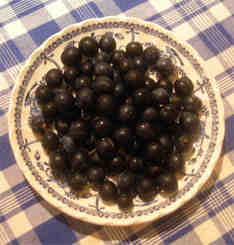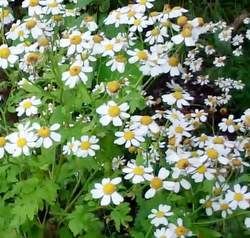Fermented sloe gin recipe: a new approach to making sloe gin
Posted by Fiona Nevile in Liqueurs | 52 comments
A dish of innocent ripe sloes waiting to be transmorigified
I love sloe gin and like most other sloe gin makers am keen to make a great brew. I hate to admit it but it would be great to impress my liqueur making guru, Gilbert. This recipe gives me the possiblity of two great outcomes. This new technique may produce a superb sloe gin opera or rolling of drums.
Colin Boswell wrote, “The secret of a good sloe gin is the extent to which the very high natural tannin content plus its other constituents have been extracted. I have found that replicating, as perhaps you have above (that’s me!), red wine production by fermenting the sloes on their skins makes an outstanding sloe gin. What you must beware of is that too high a concentration of sugar will kill the yeast and no fermentation will take place.
Layer 2 inches of frozen sloes interspaced with 3 tablespoons of sugar then another 2 inches of sloes and so forth in a fermentation bucket. Add a port wine or high alcohol yeast, probably fermenting out to 14deg. The more technical can measure the specific gravity before and after fermentation to gauge the alcohol content and how much sugar needs to be added.
Stand in a warm place, keep a close eye on fermentation and add small amounts of sugar until fermentation ceases.
Fermenting will of course raise the alcohol content but more importantly it extracts the full flavours of the sloes which other methods fail to do.
I would greatly appreciate the views of an experienced amateur winemaker on this.”
We make wine but are in no way experienced winemakers. So I couldn’t comment intelligently on the method. Instead I decided to give this method a go. I must admit I never would have considered fermenting the sloes before adding the gin but I haven’t been thinking laterally as regards sloe gin. I can see the wisdom behind this method, upping the alcohol level before adding the gin. As Colin says, why let the sloes become imbued with the gin – unless you are going to use the sloes for something else (they can be added to mince pies, Christmas cake, chocolate or the boozy crumble that will have you mother-in-law finally sleeping in a heap under the table).
For this experiment I am using 2 pounds of sloes (900g). I am planning to use the fermented sloes for sloe sherry.
You can get a range of good red wine yeasts online from many sources. I use the art of brewing .
I asked Colin for the ratio mix of fermented sloes to gin and received this reply.
“6l fermented sloe juice to .4l gin, assuming sloe juice has reached 15% alcohol, will give sloe gin at 25%. 50/50 gives 27.5% alcohol. By comparison, if the sloe juice was not fermented, alcohol content at .6l/.4l gin is 16% and at 50/50 20%. The gin and sloe juice need at least two months, preferably longer but should be acceptable by Christmas.
I also recommend the addition of juniper berries, 10 to a gallon of sloes.”
Leave a reply






Has anyone had any more recent reports on this? I have currently got two batches of Sloe Wine on the go, which I started last week.
I used 2lb of frozen sloes, 1lb of sugar (another lb to be added later) 5 oz of chopped sultanas and 4 pints of water and a campden tablet. I then added a dessert type wine yeast.
The second batch was a bit of a simpler version with smaller quanities of sloes, no sultanas and more sugar, plus dessert wine yeast. I was going to use the second batch for sloe gin, but might try both. I have also come across a slightly mad sloe champange type recipe which I will also try a bit later on in the season. And I have a big bag of Haws to get through too…
Further update. Made the mix 2 parts sloe wine, one part gin. Tested with 2 oz and 4oz of sugar per bottle added.
The consensus was that the 4oz mix was about right. But the mix was still not nearly fruity enough and was a pale shadow of sloe gin made in the traditional way. Further it is simply not worth wasting two thirds of a bottle of sloe wine on it. I would be interested to hear from anyone who has actually done this rather than just speculated about it. I dare say it would improve with age but so does the trad sloe gin.
The sloe wine is a revelation even with no aging this is a very tasty tipple. Our tasters prefered this to the chemically manufactured sloe gin.
Update on my comparison of making sloe gin by traditional and by mixing sloe win and gin. Duly mixed ine and gine at 50:50. The wine mix is definitely clearer as good as you get if you put sloe gin through coffee filters. However it the smell is ginny and the taste not so good. Added 2.5 oz of sugar to mix and 5 oz to mix. Smell better after two days mixed but still ginny. At blind tasting, all agreed that traditional was best by some way. 2.5 ozs very ginny, and 5 ozs although swetter than traditional lacked character and taste. Going to try 2 parts wine and one part gin (around 20% alcoloh) next. Will report.
Sloe wine very good and another gallon made.
I did the fermentation method by mistake a couple of years back! I ran out of gin I had about 8cm high left in the bottle. As it was late I put the sloes, sugar and cinnamon sticks in, shook the bottle and sealed it. I put it to the back of the cupboard and made a mental note to get some gin and forgot! 6 months later whilst sorting through the cupboard I found the bottle, there was quite a hiss when I undid it and the fumes well. I added the gin and left another couple of months – my husband said it was the best!
Hi Graham
Thanks for all these tips – much appreciated.
Almost worth swimming to Spain to get the gin!
I am making a lot of sloe gin this year for a family party. About a dozen in the conventional way and another dozen by mixing gin with fermented sloes(sloe wine). I cannot see any advantage in not making the sloe wine in a conventional way from a simple recipe in a demijohn as this minimises the chance of the wine spoiling. Any comments? When the wine is clear (it is just about ready and v nice medium sweetness) I will mix 50:50 with gin and then experiment with additional sugar for taste. I will let you know how I get on.
If you catch a ferry to Spain, there is some very acceptable gin at Carrefour in Santander for E3.80 which means using the fermentation method a 25% strength sloe gin would cost lessthan £2
HI MAYBE COULD SORT YOU OUT BUT TRYING TO FIND MY LAST CROP IT COULD BE A RESULT ILL LET YOU KNOW VERRY SOON THE ONLY DOWN FALL IS THAT I LIVE IN EXETER BUT DO MY BEST FOR YOU
Hi all you Sloe and Damson gin lovers!
Does anyone know where I can buy some frozen damsons in the Kent/Sussex area?
I missed the harvest and am fast running out of previous brews!!
🙁
hi thanks for that not tried it that way i shal have to next year and tell you how i got on we dont get much frost down this end so the berries would shrivel up before we had any chance of frost has anyone tried sloe and plum gin if so whats the recipe for that if its not something you wan to disclose
Hello yep freezer is good! if I waited for the first frost near hastings in sussex it would probably be january (joking)early dec may be then no sloes which there is an abundence of a week ago.then I bashed them lightly with a rolling pin frozenthen fermented them or added them to sugar and gin in bottles.